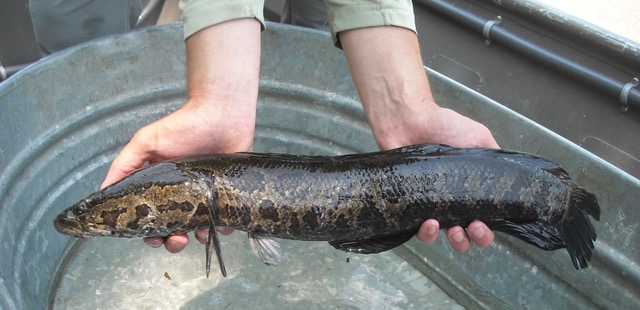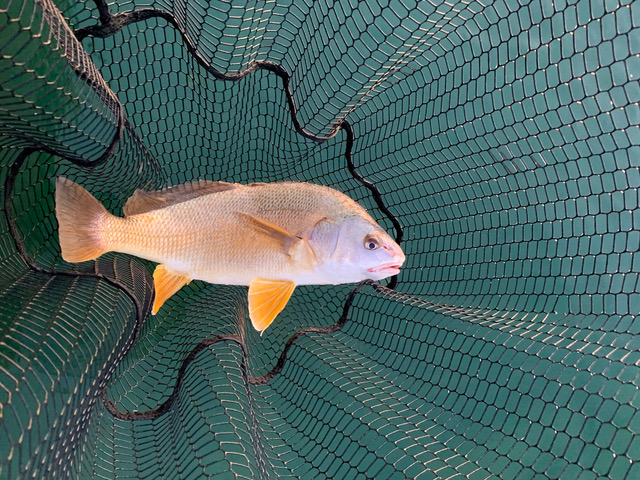
Invasive fish in Delaware River pose growing threat, officials warn
| November 8, 2023
Officials warn that several species of invasive fish have appeared in growing numbers in the Lower Delaware River basin, posing a threat to native fish and harming the environment.
Freshwater Drums, Blue Catfish, and the Northern Snakehead are among these invasive species that have been making their way into the river, according to the Pennsylvania Fish and Boat Commission.
“They’re all piscivorous, meaning they eat other fish,” Jacob Bransky, senior aquatic biologist at the Delaware River Basin Commission, said in an interview. “And they grow to large sizes, especially the Blue Catfish, so they can really consume a lot of the native species that are found in these systems.”
The danger then is that these invasive fish can repopulate faster than the native species of fish being killed off.
The Fish and Boat Commission said that anglers who fish in the river have the highest likelihood of spotting one of these invasive species because they spend more time on the river.
The commission encourages the public to help reduce the population of invasive species: If an angler catches one, the commission asks that the fish be photographed, harvested (prepared for consumption) or discarded (thrown in the trash) and reported to the commission’s online invasive species form.
Freshwater drums are a North American saltwater type of fish that can also survive in freshwater. They have been spotted in the tidal portion of the Delaware River, as well as upstream close to Upper Black Eddy. Adults will grow to be between five and 15 pounds.
Not much is known about the environmental impacts of Freshwater Drums on native species, but they feed on mussels. That, in turn, will affect the mussel population of the river basin.

How they got here
“Blue Catfish were originally introduced into the Chesapeake Bay for sport fishing purposes, and slowly, over time, those catfish have moved up the Chesapeake Bay system and then across the C&D Canal into the Delaware,” Bransky said.
Blue Catfish, which were introduced into the Chesapeake Bay area in the 1960s and ’70s, have also been captured in areas of the Commodore Barry Bridge in the lower Delaware River.
Blue Catfish adults typically weigh around 30 pounds, but can weigh over 100 pounds, making them the largest type of catfish found in North America. Combined with their size, these fish have affected native species in the river basin.
The Northern Snakehead is typically found in the Upper Delaware, and threatens many native fish. They originated from China, Russia and Korea, and it’s theorized that they were introduced into the United States through fish markets.
It is now illegal to sell, barter, possess or transport a snakehead in Pennsylvania.
“They were likely brought here through either the food trade or aquarium pet trade,” Bransky said. “They are also a popular fish to eat in Asian cultures. They first showed up in some of the ponds down by the stadiums in Philadelphia, and those ponds down there in FDR Park are connected tidally to the Delaware River,”
The first population recorded in the United States was in Maryland in 2002. Since then, the snakehead population has made its way up the Delaware.
How to get rid of them
Adult snakeheads can reach over 30 inches long. They grow quickly and are known to live about eight years. Snakeheads can start reproducing as early as one year old in fast-growing populations like the Lower Delaware.
Young snakeheads eat small crustaceans and insects, but once they grow to about five inches, they switch their diet to other fish. Adult snakeheads eat minnows and bluegill, among other small native fish.
Both the Fish and Boat Commission and the Upper Delaware Council ask that anyone who spots a Northern Snakehead catch it and photograph it. They also ask that the fish be killed and discarded.
Fishermen like Steve Meserve, head of Lewis Fishery in Lambertville, N.J., have come across a few snakeheads recently.
Meserve said it is uncommon to eat snakeheads but not unheard-of either.
“I think we have gotten one or two snakeheads, which one of my crew members has informed me is very good eating,” he said. “Our stance at the moment is to deal with them through consumption.”
Although there has still not been a solution to get rid of invasive species entirely, there are things that anglers and others who come across the fish can do to help: Blue Catfish can usually be prepared to eat and Freshwater Drums, which have a flavor similar to shrimp, can be boiled and are also used frequently as chum bait.
Other methods have been used, such as netting and electrofishing, and the use of special pesticides on invasive species have shown some results.
The introduction and cultivation of non-native species into environments where they are normally not present is illegal.




![DC_Image [Image 4_Assunpink Meets Delaware] meets Delaware The Assunpink Creek on its its way to meet the Delaware River. The creek passes through woods, industrial and commercial areas and spots both sparkling and filled with litter.](https://delawarecurrents.org/wp-content/uploads/bb-plugin/cache/DC_Image-4_Assunpink-meets-Delaware-1024x768-landscape-14f069364113da5e8c145e04c9f2367c-.jpg)




Wow! Very informative article!
Great job Keri! Very informative article and learned a lot.
More, more, more!
Now I want to go fishing in the Delaware River.
Well I have caught a lot of blue and flat head catfish in the Delaware river and a few snake head fish there are more flat head catfish then blue catfish and not as many snake head fish I am a avid fisherman with about 30 years of fishing the Delaware river and I have seen an Increase in the flat head catfish Population, then any other fish that I catch in the Delaware river even the blue Gill and white perch have decreased in the last 5 years.